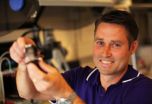(Press-News.org) Australian astronomers have shown galaxies in the vast empty regions of the Universe are actually aligned into delicate strings in research published today in the Monthly Notices of the Royal Astronomical Society.
A team of astronomers based at The University of Western Australia node of the International Centre for Radio Astronomy Research (ICRAR) has found short strings of faint galaxies in what were previously thought to be extremely empty parts of space.
The Universe is full of vast collections of galaxies that are arranged into an intricate web of clusters and nodes connected by long strings. This remarkably organized structure is often called the 'cosmic web', with busy intersections of galaxies surrounding vast spaces, empty of anything visible to us on Earth.
"The spaces in the cosmic web are thought to be staggeringly empty," said Dr Mehmet Alpaslan, who led the research. "They might contain just one or two galaxies, as opposed to the hundreds that are found in big clusters."
These huge, empty regions are called voids, and for years, astronomers have been trying to understand the small population of galaxies that inhabit them.
Using data from the Galaxy and Mass Assembly (GAMA) survey, Alpaslan and his colleagues found that the small number of galaxies inside these voids are arranged in a new way never seen before.
"We found small strings composed of just a few galaxies penetrating into the voids, a completely new type of structure that we've called 'tendrils'," said Alpaslan.
To discover tendrils, the GAMA team created the largest ever galaxy census of the southern skies using observations from the Anglo-Australian Telescope in NSW, Australia.
"Our new catalogue has looked deeper into space and mapped each patch of sky up to ten times to make sure it's as thorough as possible," said Dr Aaron Robotham from The University of Western Australia node of ICRAR.
"We weren't sure what we'd find when we looked at voids in detail, but it was amazing to find so many of these tendrils lurking in regions that have previously been classified as empty," said Robotham.
"This means that voids might be much smaller than we previously thought, and that galaxies that were previously thought to be in a void might just be part of a tendril," said Alpaslan.
The GAMA team plan to catalogue more tendrils for further study as their detailed map of the Universe expands.
INFORMATION:
Further Information
ICRAR is a joint venture between Curtin University and The University of Western Australia that receives funding from the State Government of Western Australia. Mehmet Alpaslan is a PhD candidate at St Andrews University, Scotland and is supervised by Professor Simon Driver and Dr Aaron Robotham at The University of Western Australia node of ICRAR.
The Galaxy and Mass Assembly (GAMA) survey is an international collaboration to map the Universe led by Professor Simon Driver at ICRAR.
GAMA website: http://www.gama-survey.org/
Contacts
Dr Mehmet Alpaslan (Timezone: US Pacific Standard Time, GMT-8)
PhD Graduate – St Andrews University
M: +1 702 848 97 28
E: mehmet.alpaslan@icrar.org
Dr Aaron Robotham (Timezone: Australian Western Standard Time, GMT+8)
ICRAR – UWA
Ph: +61 8 6488 5564
E: aaron.robotham@icrar.org
Kirsten Gottschalk (Timezone: Australian Western Standard Time, GMT+8)
Media Contact, ICRAR
Ph: +61 8 6488 7771
M: +61 438 361 876
E: kirsten.gottschalk@icrar.org
These aren't the voids you're looking for
Astronomers find faint strings of galaxies inside empty space
2014-03-10
ELSE PRESS RELEASES FROM THIS DATE:
A tricky balancing act: Antibiotics versus the gut microbiota
2014-03-10
(March 10, 2014) Antibiotics are valuable, potentially life-saving tools that have significantly reduced human morbidity and mortality. Unfortunately, antibiotics may also have unintended consequences from their off-target effects that may increase the risk of many long-term conditions. Recent epidemiologic studies have detected a possible link between antibiotic use in childhood and weight gain1 — with disruption to the normal gut microbiota considered the most likely cause.
"Infancy is an important time in the development of the human microbiota and these studies provide ...
Feeding gut microbiota: Nutrition & probiotics are key factors for digestive health
2014-03-10
(March 10, 2014) A healthy and balanced diet, as well as probiotics, have been known to be helpful in preserving gastrointestinal health for quite a long time. But it is only recently that the underlying mechanisms have become somewhat clearer. A rapidly increasing body of knowledge promises to further clarify the effects of our daily food on the gut microbiota and to indicate more targeted applications of probiotics in the near future. This was one of the topics presented at the Gut Microbiota for Health World Summit in Miami, FL, USA. On March 8-9, 2014, internationally ...
Lower IQ in teen years increase risk of early-onset dementia
2014-03-10
Men who at the age of 18 years have poorer cardiovascular fitness and/or a lower IQ more often suffer from dementia before the age of 60. This is shown in a recent study encompassing more than one million Swedish men.
In several extensive studies, researchers at the Sahlgrenska Academy of Gothenburg University have previously analyzed Swedish men's conscription results and were able to show a correlation between cardiovascular fitness as a teenager and health problems in later life.
Increased risk for early-onset dementia
In their latest study, based on data from 1.1 ...
Healthy eating may reduce the risk of preterm delivery
2014-03-10
In the study, which was conducted by researchers from the University of Gothenburg, Sahlgrenska University Hospital and the Norwegian Institute of Public Health, the participants completed a scientifically evaluated questionnaire about what they had been eating and drinking since becoming pregnant.
The researchers also had access to information about the women's general lifestyle e.g. level of education, living conditions, income, weight, physical activity, smoking habits, alcohol consumption, number of children and medical factors such as history of preterm delivery.
15 ...
Computer system simulates the behavior of tax evaders
2014-03-10
Tax fraud is a very serious problem for society, especially in Spain, where tax evasion represents almost one-fourth of its Gross Domestic Product. On the one hand, evasion is a problem because it produces a loss in public resources, something which is especially difficult in a time of economic crisis with cutbacks in public funding; on the other hand, tax fraud damages the effectiveness of justice within the tax system, since not everyone is able to evade taxes equally, thus leading to injustices between small and large companies and between the self-employed and employees. ...
New sugar-test to reduce false-positive cancer diagnoses
2014-03-10
The world's most widespread test for ovarian cancer reports false-positives in 94 of 100 diagnosed cases. Now, chemists at the University of Copenhagen working with clinical researchers at University College London have developed a method able to halve the number of false-positives. When fully developed, the new test will spare a significant number of women from unnecessary worry and further testing. Furthermore, global health care providers stand to save substantial sums – just by including a test on a certain sugar molecule in tandem with the currently prevailing diagnostic ...
There is no beating the breathalyzer this St. Patrick's Day (video)
2014-03-10
WASHINGTON, March 10, 2014 — If you're having some drinks this St. Patrick's Day weekend, remember to have a designated driver, otherwise you may end up on the business end of a breathalyzer on the side of the road. If you think you can beat it, think again; chemistry will land you in cuffs. In the American Chemical Society's (ACS') latest Reactions video, we examine how your breath can get you busted when you've had too much to drink. The video is available here: http://youtu.be/rvVzlg26bCM
Subscribe to the series at Reactions YouTube, and follow us on Twitter @ACSreactions ...
Europe must improve its response to the threat of plant pests and diseases
2014-03-10
Potentially devastating plant pests and diseases are highlighted in a new report from EASAC, the European Academies' Science Advisory Council, the leading provider of independent scientific advice to Europe's policy-makers. In the detailed EU-wide study of emerging plant pests and diseases, EASAC describes their combined threat to crops and forests and wider ecosystems, with implications for human health. In economic terms, as admitted by the EU Commission, billions of euros could be at stake and the environmental impact may be irreversible. Prof. Anne Glover, Chief Scientific ...
Young skin cancer survivors at risk of other cancers later
2014-03-10
Australian author on the paper, Professor Rodney Sinclair, Professor of Medicine at the University of Melbourne and Director of Dermatology at Epworth HealthCare said that the risk decreased significantly with increasing age, but it remains higher compared with individuals who have never had NMSC.
"The risk for developing any cancer subsequent to NMSC decreases significantly with increasing age: 23 times higher risk for those under 25 years of age; 3.52 for those 25-44 years of age; 1.74 for those 45- 59 years of age; and 1.32 for those older than 60 years.
Published ...
Rice synthetic biologists shine light on genetic circuit analysis
2014-03-10
In a significant advance for the growing field of synthetic biology, Rice University bioengineers have created a toolkit of genes and hardware that uses colored lights and engineered bacteria to bring both mathematical predictability and cut-and-paste simplicity to the world of genetic circuit design.
"Life is controlled by DNA-based circuits, and these are similar to the circuits found in electronic devices like smartphones and computers," said Rice bioengineer Jeffrey Tabor, the lead researcher on the project. "A major difference is that electrical engineers measure ...
LAST 30 PRESS RELEASES:
Male bonobos track females’ reproductive cycle to maximize mating success
New report outlines science priorities for human Mars exploration
Want to curb cannabis-related crashes? Don’t forget older adults, study finds
Expectant management vs medication for patent ductus arteriosus in preterm infants
Pew funds 7 new biomedical research collaborations
The ERC selects 349 mid-career researchers for €728 million in Consolidator Grants
ERC Consolidator Grant awarded to CISPA researcher Rayna Dimitrova
Antimicrobial effects of Syzygium aromaticum and Salvadora persica against common peri-implantitis pathogens in vitro
EVs pose no greater risk to pedestrians than conventional vehicles
Modeling microplastic accumulation under the ocean surface
Pompeii offers insights into ancient Roman building technology
University of Utah engineers give a bionic hand a mind of its own
Transient and long-term risks of common physical activities in people with low back pain
Health care contact days in older adults with metastatic cancer
Brain resilience science reshapes psychiatry from treating illness to building strength
An assessment of the antidepressant potential of deramciclane in two animal tests
Pitt and UPMC study finds epigenetic signature of pediatric traumatic brain injury, paves way for precision recovery tools
Brain discovery opens door to earlier detection of metabolic syndrome in women
SwRI-led study provides insight into oscillations in solar flares
Announcing the third cohort of the Hevolution/AFAR new investigator awards in aging biology and geroscience research
GeoFlame VISION: Using AI and satellite imagery to predict future wildfire risk
Nationwide study suggests that water treatment methods may impact the risk of legionnaires’ disease
Oyster larvae on drugs move slowly and are stressed
Targeting a specific brain circuit may help prevent opioid relapse, WSU study finds
Tec-Dara combination offers substantial improvement over standard second-line therapies for relapsed or refractory multiple myeloma
Improving treatment for an autoimmune bleeding condition
Drug reduced need for blood transfusions during hospitalization for non-cardiac surgery
Novel agent ianalumab added to standard therapy extends time to treatment failure in patients with previously treated immune thrombocytopenia
Pirtobrutinib outperforms bendamustine plus rituximab for previously untreated CLL/SLL
Online tracking and privacy on hospital websites
[Press-News.org] These aren't the voids you're looking forAstronomers find faint strings of galaxies inside empty space





